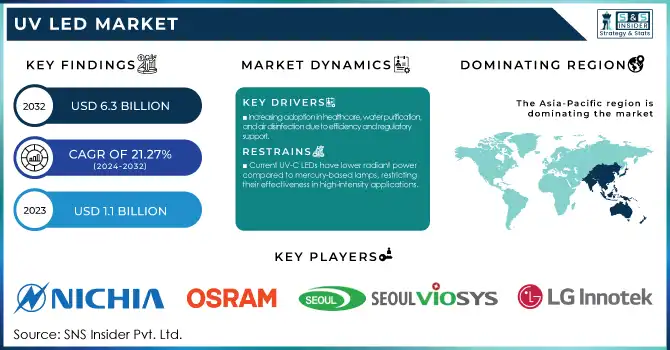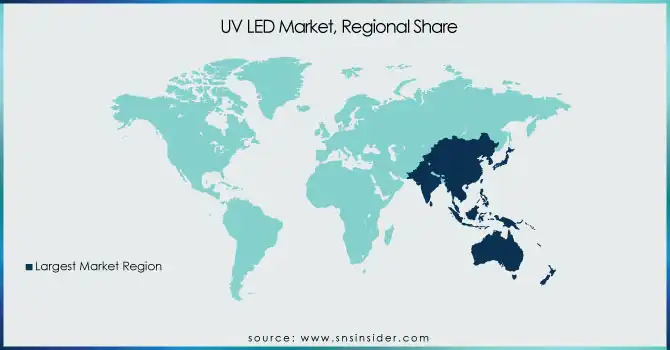UV LED Market Size & Trends:
The UV LED Market Size was valued at USD 1.1 Billion in 2023 and is expected to reach USD 6.3 Billion by 2032, growing at a CAGR of 21.27% from 2024-2032.
The UV LED market saw strong wafer production in Asia-Pacific, with high fab capacity utilization driven by demand for UV-C LEDs in sterilization and water purification. Chip design trends focus on deep UV applications, higher power density, and longer lifespan, while supply chain challenges were mitigated through localized manufacturing. R&D efforts are advancing AlGaN-based deep UV LEDs, improving quantum efficiency, integrating GaN-on-Si for cost reduction, and expanding applications in phototherapy and advanced curing.

To get more information on UV LED Market - Request Free Sample Report
UV LED Market Dynamics
Drivers
-
Increasing adoption in healthcare, water purification, and air disinfection due to efficiency and regulatory support.
The rising demand for efficient sterilization solutions in healthcare, water, and air sterilization is expected to drive the market for UV-C LEDs. Compared to traditional mercury-based UV lamps, UV-C LEDs are a small, energy-efficient, environmentally friendly solution. As the proliferation of mercury-free lighting is accelerated by regulatory support and the efficiency of wavelengths available at the deep UV end of the spectrum increases, UV LEDs can be seamlessly integrated into consumer and industrial applications. With the rise in awareness about microbial contamination and the need for sustainable disinfection solutions, demand for such products is expected to grow soon thus contributing to the market growth over the forecast period.
Restraints
-
Current UV-C LEDs have lower radiant power compared to mercury-based lamps, restricting their effectiveness in high-intensity applications.
Current UV-C LEDs frequently are unable to reach the same levels of radiant power as traditional mercury-based lamps, particularly in high-intensity applications such as industrial disinfection and large-scale water treatment. These obstacles are related to high external quantum efficiency and good thermal dissipation at deep UV wavelengths. Deep UV emitter AlGaN materials have defects that reduce the light output efficiency and are highly beneficial for integration. LEDs are small and hence can only meet high UV light output in small areas becomes a hindrance. However, for applications needing extreme and wide-area UV exposure, mercury-based solutions might remain necessary.
Opportunities
-
Enables larger wafer sizes, lower production costs, and better scalability for UV LED applications.
The integration of Gallium Nitride into Silicon technology in UV LEDs is a huge opportunity for cost reductions and high-volume mass production. Sapphire-based substrates are not only expensive but also come with a scaling problem, GaN-on-Si allows larger wafer sizes, with better cost efficiency and heat dissipation. This technology can speed up the uptake of UV LED in end-user markets spanning consumer electronics, medical fields, and industrial curing. With more and more research institutes and semiconductor companies in progress to improve GaN-on-Si processes towards even higher efficiency and longer lifetime of the UV LED. UV LEDs will eventually become a viable competitor to conventional UV light sources, which are widely used in industry, thus supporting the transition to sustainable, mercury-free lighting technologies.
Challenges
-
UV-C LEDs face material degradation and thermal issues, affecting long-term reliability.
The UV LED market faces a highly impactful economic challenge around performance degradation with time, especially with UV-C LEDs. Exposure to high-energy UV destruction causes the material to degrade, thus lowering both light output and lifetime. One of the major aspects is thermal management because high temperatures can contribute to wear and thus restrict long-term reliability. Developments in encapsulation materials, heat dissipation techniques, and substrate innovations aimed at improving LED robustness are all being pursued by manufacturers in a bid to make such LEDs more commercially viable; increasing lifetime predictability is also being pursued. Currently, however, applications needing prolonged high-intensity UV exposure, for example, in industrial disinfection and water treatment, will continue to depend on traditional mercury-based UV lamps until we can fully overcome these challenges.
UV LED Market Segment Analysis
By Power Output
The 1W-5W segment dominated the market and held a revenue share pf more than 42% in 2023, Driven by general disinfection, curing, and medical applications. For the majority of commercial applications, these LEDs are the perfect blend of power output and energy consumption.
The More than 5W segment is predicted to record the fastest CAGR during the forecast period since there is growing demand for high power UV LEDs for industrial and large scale disinfection applications. This makes these LEDs particularly valuable for more demanding environments such as water purification and industrial sterilization, where the high output capacity implies a potential for significant growth during 2024-2032.
By Application
UV curing segment dominated the market and represented significant revenue share in 2023, driven by its broad industrial applications, particularly for coating, printing, and adhesive curing. They emit faster processing and greater efficiency, making UV LEDs increasingly popular in diverse industries.
The disinfection and sterilization segment is projected to witness the fastest compound annual growth rate growth during 2024-2032, owing to the increasing demand for hygiene solutions in the healthcare, food, and water treatment industries. From the end-user segment, the domestic segment leads in terms of value and volume and is expected to continue doing so in the upcoming years on account of the increasing application of contactless disinfection demand which will help the market grow rapidly during the forecast period.
By Technology
The UV-c segment dominated the market and held the largest revenue share of more than 48% in 2023 as it offers higher efficiency from the disinfection and sterilization applications of UV LEDs. UV-C LEDs are deployed in many applications such as UV-C water disinfection, air sterilization, and surface disinfection, especially in healthcare and industrial uses. These provide efficient microbial inactivation and are preferred, as they have a smaller footprint and are more environmentally friendly.
The UV-A segment is expected to grow at a fastest CAGR owing to applications such as counterfeit detection and phototherapy in which non-toxic UV light sources is increasingly being sought.
By End-Use
The industrial segment dominated the UV LED market and represented significant revenue share in 2023, As widespread use in curing applications, material testing, and disinfection in manufacturing plants. There is a multitude of industrial processes that require high-efficiency UV LEDs; for surface sterilization or polymer curing to name just a couple of use cases.
The healthcare segment is anticipated to achieve the fastest CAGR due to the increasing adoption of UV LEDs for medical sterilization, wound healing, and light therapy applications. As technology for medical applications develops and more investments are made in healthcare infrastructure, the adoption of UV LEDs will continue to increase in healthcare.
UV LED Market Regional Landscape
Asia-Pacific held the largest share of the UV LED market owing to the high presence of UV LED manufacturers and increasing demand from electronics, automotive, and healthcare industries. In the region, production and consumption of UV LEDs are significant and the main countries involved in the UV LEDs market are China, Japan, and South Korea.
North America is projected to observe the fastest CAGR throughout the forecast period, Driven by growing demand for UV-C LEDs in healthcare and commercial disinfection and sterilization applications. A strict regulatory environment and increasing adoption of green technologies would continue to fuel regional market growth in North America.

Get Customized Report as per Your Business Requirement - Enquiry Now
Key Players
The major key players in UV LED are
-
Nichia Corporation – NCSU334B UV-C LED
-
Osram Opto Semiconductors – Oslon UV 3636
-
Seoul Viosys – Violeds UV-C LED
-
Crystal IS – Klaran WD UV-C LED
-
LG Innotek – UV-C LED Module
-
Lumileds – LUXEON UV U1
-
Stanley Electric Co., Ltd. – UV-C LED P8T2226
-
Honle UV America Inc. – LED Powerline AC/IC
-
Bolb Inc. – Deep UV LED 275nm
-
Nitride Semiconductors Co., Ltd. – NS365L-3SV
-
Epitop Optoelectronic Co., Ltd. – EpiLED UV-A LED
-
Photon Wave Co., Ltd. – PW3535 UV LED
-
Dowa Electronics Materials Co., Ltd. – DUV LED 265nm
-
Sensor Electronic Technology, Inc. (SETi) – UVClean 265nm LED
-
Qingdao Jason Electric Co., Ltd. – UV-C Disinfection Module
Recent Developments
-
January 2024: Nichia Corporation began mass production of its new high-radiant flux UV-C LED, the NCSU434C, designed for industrial water and air applications.
-
April 2024: GEW unveiled a groundbreaking new UV LED system at drupa 2024, expanding its product portfolio to include advanced LED systems for sheetfed offset and industrial printing applications.
| Report Attributes | Details |
|---|---|
| Market Size in 2023 | USD 1.1 Billion |
| Market Size by 2032 | USD 6.3 Billion |
| CAGR | CAGR of 21.27% From 2024 to 2032 |
| Base Year | 2023 |
| Forecast Period | 2024-2032 |
| Historical Data | 2020-2022 |
| Report Scope & Coverage | Market Size, Segments Analysis, Competitive Landscape, Regional Analysis, DROC & SWOT Analysis, Forecast Outlook |
| Key Segments | • By Technology (UV-A, UV-B, UV-C) By Power Output (Less than 1W, 1W -5W, More than 5W) • By Application (UV curing, Medical light therapy, Disinfection & sterilization, Counterfeit detection, Optical sensing & instrumentation, Others) • By End - Use (Industrial, Commercial, Residential, Agriculture, Healthcare) |
| Regional Analysis/Coverage | North America (US, Canada, Mexico), Europe (Eastern Europe [Poland, Romania, Hungary, Turkey, Rest of Eastern Europe] Western Europe] Germany, France, UK, Italy, Spain, Netherlands, Switzerland, Austria, Rest of Western Europe]), Asia Pacific (China, India, Japan, South Korea, Vietnam, Singapore, Australia, Rest of Asia Pacific), Middle East & Africa (Middle East [UAE, Egypt, Saudi Arabia, Qatar, Rest of Middle East], Africa [Nigeria, South Africa, Rest of Africa], Latin America (Brazil, Argentina, Colombia, Rest of Latin America) |
| Company Profiles | Nichia Corporation, Osram Opto Semiconductors, Seoul Viosys, Crystal IS, LG Innotek, Lumileds, Stanley Electric Co., Ltd., Honle UV America Inc., Bolb Inc., Nitride Semiconductors Co., Ltd., Epitop Optoelectronic Co., Ltd., Photon Wave Co., Ltd., Dowa Electronics Materials Co., Ltd., Sensor Electronic Technology, Inc. (SETi), Qingdao Jason Electric Co., Ltd. |

